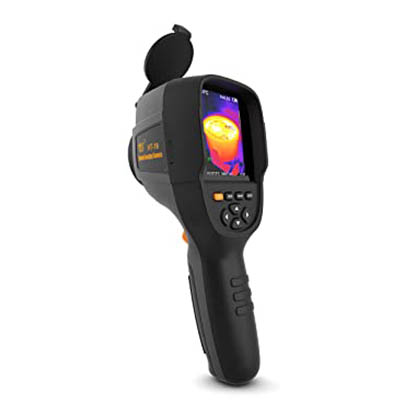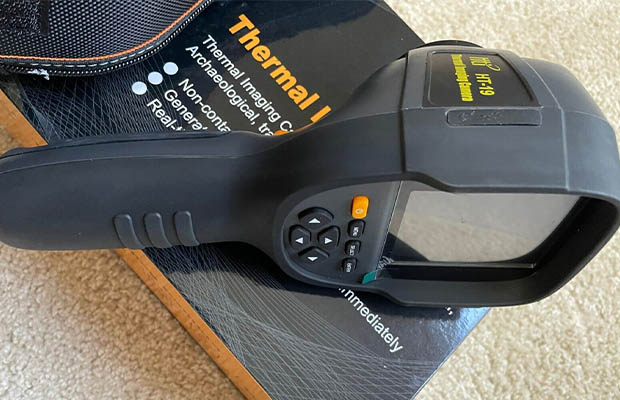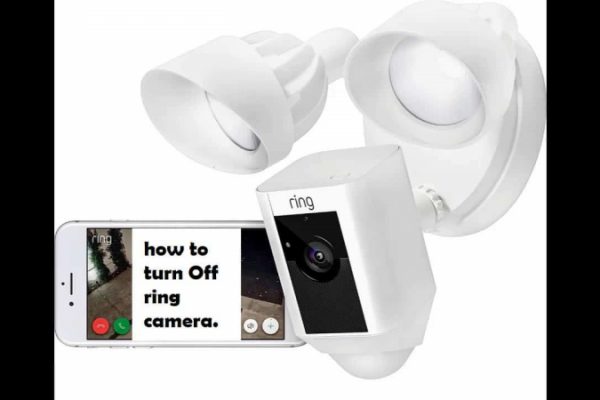The HT-19 is a fairly advanced thermal imager with 320×240 thermal resolution and a visual camera that supports a “fusion” image that combines a visual and thermal representation of what you’re looking at. Although I’ve found the resolution to be generally sufficient to not need to worry with this very often, it can be useful to help distinguish precisely what’s hot.
The Flir line has been successfully challenged by the HT-19 Thermal Camera, a handheld thermal camera. In our HT-19 review, we will delve deeper into the reasons why.
Read More: Paper Shoot Camera Review
Table of Contents
- First, What Is Thermal Imager?
- Pros Of HT-19 Thermal Camera
- Cons Of HT-19 Thermal Camera
- Key Specifications Of HT-19 Thermal Camera
- HT-19 Thermal Camera: Specs Review
- Thermal Imaging Quality Review
- Temperature Range And Accuracy Review
- Battery Life & Memory Review
- Some Customer Reviews From Amazon
- Should You Buy One?
First, What Is Thermal Imager?
They are a gadget that records temperature rather than visible light, and they are a ton of fun to play with. If you’re doing anything that involves heat or electricity, you would probably benefit from having access to one occasionally. They’re also incredibly helpful for a variety of troubleshooting around the home and property. Additionally, they are incredibly helpful for tasks like “finding where your house leaks energy” by locating the hot or cold areas (based on the season).
They have, however, historically been extremely expensive, making them relatively uncommon outside of some very pricey and high-end versions used in the industry. They have, however, recently become more affordable, whether they are standalone handheld imagers or just cell phone modules.
Pros Of HT-19 Thermal Camera
- Very high IR resolution
- An accessible, replaceable battery
- high thermal sensitivity
- Wide viewing angle
Cons Of HT-19 Thermal Camera
- Despite using the data in live view, does not store thermal information in the images.
Key Specifications Of HT-19 Thermal Camera
- Type: Handheld
- Resolution:320 x 240
- Pixels: 76800 pixels
- Connectivity: Micro USB 2.0
- Temperature range: -4°F to 572°F (-20 °C to +300 °C)
- Accuracy: +/- 2 ° C
- Thermal sensitivity: 0.07° C
- Storage Type: Internal 3 GB
- Battery capacity: 3 hours
- Applications: HVAC, Electric, Auto repair, Pipeline, Roofing, Electrical Inspection, Automotive diagnostics
- Features: Waterproof, Dustproof, Manual Focus, Visual Camera
HT-19 Thermal Camera: Specs Review

The HT-19 is a portable thermal camera with an infrared sensor and a visible light camera. You’re correct—there is at least one other model that looks identical and is known as the Vividia HT-19—but you might have seen this device somewhere else but not under the Hti brand.
The device has a micro USB port that can be used for charging and USB cable-based image transfer. We particularly appreciate that Hti Xintai has included a cap to protect the IR sensor and camera lens from dust, dirt, and scratches.
The LCD screen, a row of at least 8 buttons, and the trigger for taking pictures are all visible on the front of the thermal imaging camera.
If we take a closer look at our HT-19 review, we can see that there are three spot thermal measurements available during the live view. One each for the center spot, the center spot, and the hot spot.
Five different color schemes are available from the camera: White heat, Black heat, Cold Color (Cool), Iron Oxide Red, Rainbow (Spectra), and Cold Color. In general, grayscale palettes work better for identifying the coldest or warmest points, while a rainbow gives you a more varied picture that identifies the warmest areas.
Multiple image enhancement modes are available on the camera. The visible light camera image can be seen alone or blended with the infrared image to a certain extent (25, 50, or 75 percent). You could also just use your infrared vision.
You can modify emissivity in the camera. Why wouldn’t you just leave it on default and why would you want to do that? The reason for this is that if you know the emissivity value of your material and give it to the camera, you will receive a reading that is more accurate. As a general rule, the lower the emissivity, but you can find tables online for any material.
You’ll find more or less the typical options for a handheld thermal camera in the settings menu. You can set the auto-shutdown feature to shut down after 5 or 20 minutes, and you can change the brightness to low, medium, or high. The language, temperature unit, date, and time can all be changed, as well as the temperature between Celsius and Fahrenheit. You can disable spot measurement if you’d like.
The thermal images you took can be viewed and deleted in the picture gallery as well. Like on a Flir device, there is no option to edit them.
Thermal Imaging Quality Review
Let’s examine this infrared camera’s image quality in our review of thermal cameras. The Infrared Sensor has an IR resolution of 320 x 240 pixels, which adds up to 76,800 pixels in total. It may sound funny to those of you looking into purchasing your first thermal camera, but those of you who are already familiar with infrared cameras will understand that this is actually a high-resolution device. The HT-19 is more expensive than most thermal cameras, which typically only have 32,000 pixels.
The thermal images are stored in JPG format, but you should be aware that this is not a radiometric model; it merely stores the image without the temperature data for each pixel. Since it can do that and can display the hottest and coldest pixels while you watch in real time, I find it extremely perplexing why it doesn’t at least transfer that data to a CSV file. Do they simply not care, or do they not trust the data? As a software developer, I can say with certainty that, given that you already have the thermographic data, this algorithm is not difficult.
However, there is no manual focus mode; this is a fixed focus thermal camera. The HT-19 also has the highest legal frame rate possible, a 9Hz refresh rate.
Temperature Range And Accuracy Review
Aspects of temperature measurement accuracy and sensitivity will also be discussed in our HT-19 review. The 0.07° C sensitivity of this particular thermal camera is standard for cameras costing this much, so it is not necessarily an advantage. Due to the fact that the price range for most other thermal imaging devices is typically between 0.10 and 0.15, it is a good value.
It is capable of measuring temperatures between -20 and 300 celsius. This ought to work well in the majority of situations, enabling you to determine whether your freezer is operating properly as well as for troubleshooting heating systems or proper insulation on ovens. Keep in mind that the device’s operating range is from 0 to 45 degrees Celsius, so prolonged use in subzero temperatures is not recommended.
The field of view is sufficient, with a viewing angle of 56 degrees by 42 degrees, and the temperature accuracy is reasonable, at +/- 2 degrees Celsius.
Battery Life & Memory Review
The internal memory of this thermal imager is 3GB, and according to the manufacturer, this memory should hold about 20,000 images. Even if their estimate is not entirely accurate, you should be able to store more than 15,000, which is undoubtedly a lot more than what Flir cameras are capable of.
It has a built-in rechargeable 18650 Li-Ion battery that can run the gadget for two to three hours while performing thermal imaging.
The HT-19 does not have an IP rating, so it is safe to assume that it is neither waterproof nor dustproof. Now, you couldn’t tell by looking at the enclosure because it is fairly well constructed.
A color screen in the form of a 3.2″ LCD screen with a 320 x 240-pixel resolution is included with this thermal device.
This camera can be used for temperature monitoring, building inspections, HVAC, insulation problems, and electrical fault detection to determine where fuses overheat.
Some Customer Reviews From Amazon
- “Very simple to use, and if you’re close, it works well. Although distance makes it less dependable, it performs admirably considering the cost.”
- “This thermal imager is great and does everything I need it to. The time it takes to boot up after starting is my one and only complaint. The entire process lasts about 20 seconds. Unless you urgently need to know the current relative temperatures of something, this doesn’t sound like much. “
- “I must admit that when I first got this and played around with it, I was happy with the pictures. However, I found out the software doesn’t work when I started to work seriously on it for my project, and the manufacturer’s website didn’t provide a downloadable alternative. “
- “Using this camera is like developing new senses. It’s amazing how much you can see now that you previously couldn’t!”
Should You Buy One?
The need for a personal thermal imager might not exist. A thermal imager must be available in your social circle. Yes, if you’re “that guy” with the cool tools, you should buy one and be ready to loan it out frequently.





